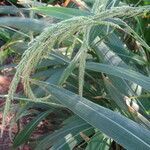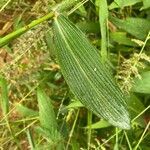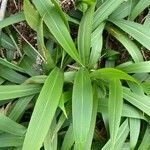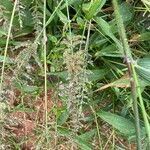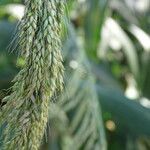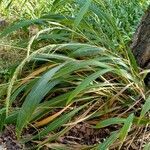Perennial from a short knotty rhizome. Culms erect or slightly geniculate, 75–200 cm tall, 3–7(–10) mm in diam. Leaf sheaths usually sparsely hispid, margins tuberculate-ciliate near ligule, otherwise glabrous; leaf blades fusiform-lanceolate, plicate, 20–60 × 2–7 cm, glabrous or hispid, narrowed toward base, apex acuminate; ligule 2–3 mm, ciliate. Panicle 20–60 × 2–10 cm, branches up to 20 cm, laxly spreading, flexuous, some spikelets subtended by a single 5–15 mm bristle. Spikelets broadly lanceolate, 3–4 mm, acute; lower glume triangular-ovate, 1/3–1/2 as long as spikelet, obtuse to acute; upper glume ovate, 1/2–3/4 as long as spikelet, 5–7-veined, acute; lower lemma neuter, often distinctly longer than upper floret, 5-veined, tipped with a short incurved beak; lower palea narrow, hyaline, 2/3 as long as lemma; upper lemma indistinctly rugulose to almost smooth, slightly shiny, apex apiculate, green and compressed. Fl. and fr. Aug–Dec. 2n = 36, 54.
A grass with a broad leaf blade. A plant grows from 60 cm to one metre tall. It has a knotty rhizome or underground stem. The leaves are 2 to 8 cm wide, 30-40 cm long and folded along their length. The leaf blade is folded like a fan and is hairy. The plant forms a clump of shoots and is about 1 m high. The shoots are thickened near the end in cultivated types. The flower is a loose open grass flower. A range of different varieties occur. These have different amounts of red, green and white colouring on the leaf and also where the leaves wrap around the stem. The seeds are about 3 mm long and borne in large numbers on shoots at the ends of the stalks. Normally a plant produces a clump of shoots due to both suckers near the base and buds growing from the side of the short stem. There are several cultivated varieties.
